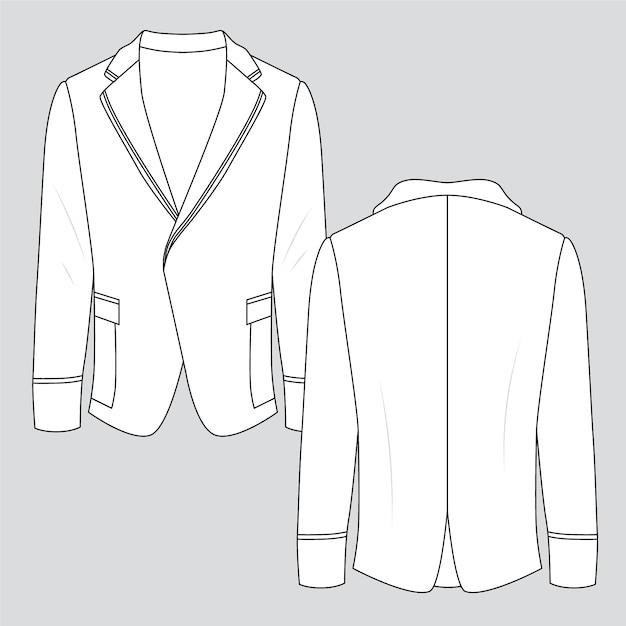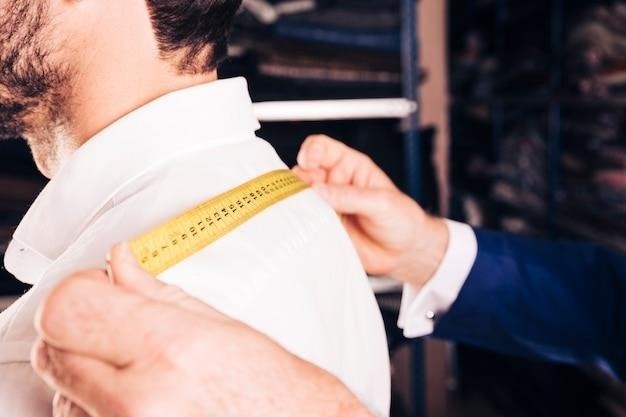Understanding Suit Jacket Sizes
Understanding suit jacket sizes can be a bit confusing‚ but it doesn’t have to be. Suit jackets are typically sized using a number and a letter. The number represents your chest measurement‚ while the letter refers to the jacket length.
The number in a suit jacket size represents your chest measurement in inches. To determine your chest measurement‚ wrap a measuring tape around your chest‚ under your arms‚ and over the fullest part of your chest. Make sure the tape is level and snug but not too tight. The number you get is your chest size‚ and it should correspond to the number in the suit jacket size you need. For instance‚ if your chest measurement is 38 inches‚ you should wear a size 38 suit jacket.
It’s important to note that suit jacket sizes can vary slightly between brands. Some brands run a bit larger or smaller than others‚ so it’s always a good idea to try on a few different jackets before making a purchase. You can also refer to a size chart on the brand’s website for more accurate sizing information.
The letter in a suit jacket size indicates the jacket length. There are three main lengths⁚ Short (S)‚ Regular (R)‚ and Long (L). You may sometimes also see XS and XL‚ which generally refer to sleeve length. The length of the jacket is determined by your height and your personal preference.
A Short (S) jacket is typically best for men who are 5’4″ to 5’7″ tall. A Regular (R) jacket is the most common length and is suitable for men who are 5’7″ to 5’11” tall. A Long (L) jacket is designed for men who are 5’11.5″ to 6’2.5″ tall. If you are taller than 6’3″‚ you may need an Extra Long (XL) jacket.
The best way to determine the right length for you is to try on a few different jackets and see what feels most comfortable. You should be able to button the jacket comfortably without it pulling or feeling too tight. The bottom of the jacket should hit your waistline and not extend beyond your hips.
Size Chart
A suit jacket size chart can be a helpful tool for determining your correct size. These charts typically list chest measurements in inches‚ along with the corresponding jacket size. The chart will also indicate the length of the jacket‚ which is represented by a letter (S‚ R‚ or L). For example‚ a size 40R jacket would have a 40-inch chest measurement and a regular length.
Size charts can vary slightly between different brands‚ so it’s important to refer to the specific chart provided by the retailer or manufacturer. If you’re unsure about your size‚ it’s always best to err on the side of caution and choose a size that is slightly larger. A well-fitting suit jacket should be comfortable to wear and allow for a small amount of movement.
Remember that suit jackets are often sized differently than other types of clothing. For example‚ a size 40 jacket may be equivalent to a size 38 shirt. Therefore‚ it’s crucial to consult a suit jacket size chart to ensure that you’re selecting the correct size for your body type.
Determining Your Size
Determining your suit jacket size involves more than just measuring your chest. While chest measurement is the primary factor in sizing‚ you also need to consider your height and desired jacket length. To find your ideal size‚ follow these steps⁚
Measure your chest⁚ Wrap a measuring tape around your chest‚ just under your armpits‚ keeping it level and snug. This measurement‚ in inches‚ will be the numerical part of your suit jacket size.
Determine your jacket length⁚ Choose a length that complements your height. Short (S) lengths are best for shorter men‚ regular (R) lengths are suitable for average height‚ and long (L) lengths are ideal for taller men. You can also find extra-short (XS) or extra-long (XL) lengths.
Consult a size chart⁚ Use a size chart from the specific brand you’re interested in to find the corresponding jacket size based on your chest measurement and desired length. For example‚ if your chest measurement is 40 inches and you want a regular length jacket‚ you would likely need a size 40R suit jacket.
Additional Considerations
While chest measurement and jacket length are crucial for determining your suit jacket size‚ there are other factors to consider for achieving a perfect fit. These factors include⁚
Brand-specific sizing⁚ Remember that suit jacket sizing can vary slightly between brands. It’s always advisable to check the size chart provided by the specific brand you’re purchasing from. Some brands might run slightly larger or smaller than others.
Personal preference⁚ Ultimately‚ the ideal suit jacket fit is a matter of personal preference. Some men prefer a slightly looser fit‚ while others prefer a more tailored look. Experiment with different sizes and styles to find what feels most comfortable and flattering on you.
Alterations⁚ If you find a suit jacket that’s almost perfect but needs a slight adjustment‚ consider having it tailored. A tailor can make adjustments to the sleeve length‚ shoulder width‚ or waistline to ensure a custom fit that flatters your body type.
Suit Jacket Size Chart
A suit jacket size chart is an essential tool for finding the right fit. It typically lists chest measurements and corresponding jacket lengths.
Chest Measurement
The number in a suit jacket size represents your chest measurement. To determine your chest measurement‚ wrap a tape measure around your chest‚ just under your arms‚ keeping it level and comfortable. Take the measurement at the fullest point of your chest‚ ensuring that the tape measure is not too tight or too loose. This measurement will be the primary guide in selecting your suit jacket size.
Remember that suit jackets are typically designed to fit slightly looser than shirts. Therefore‚ you might find that your suit jacket size is one or two sizes larger than your shirt size. For a comfortable fit‚ it’s essential to choose a jacket that allows for a bit of movement and doesn’t feel constricting.
Jacket Length
The letter following the number in a suit jacket size indicates the jacket length. This letter is crucial for ensuring a proper fit and a flattering silhouette. The most common jacket lengths are Short (S)‚ Regular (R)‚ and Long (L). Some brands may also offer Extra Short (XS) and Extra Long (XL) options.
Short jackets are typically best suited for shorter men or those who prefer a more contemporary look. Regular jackets are the most common length and usually provide a good fit for most men. Long jackets are designed for taller men or those who prefer a more classic style. If you’re unsure about which length is right for you‚ consider consulting a tailor or a stylist for personalized advice.
Size Conversion Chart
Suit jacket sizes can vary slightly between brands and countries. To ensure you get the right fit‚ it’s helpful to use a size conversion chart. These charts provide a comparison of sizes across different sizing systems‚ such as US‚ UK‚ and European sizes. For example‚ a US size 40 might be equivalent to a UK size 42 or a European size 50. You can often find size conversion charts on the websites of suit retailers or on online style guides.
It’s important to note that size conversion charts are just a guideline. Individual brands may have their own sizing variations‚ so it’s always a good idea to check the specific size chart for the brand you are purchasing from. If you’re unsure about your size‚ it’s always best to err on the side of ordering a size up. You can always have a suit tailored to fit perfectly‚ but it’s more difficult to alter a suit that’s too small.

Tips for Finding the Right Fit
Finding the perfect fit for a suit jacket is essential for a polished and confident look. Here are some tips to help you find the right size⁚
Sleeve Length
The sleeve length of your suit jacket is crucial for a flattering fit. It should end just at your wrist bone‚ with a slight break at the cuff. If the sleeve is too long‚ it will bunch up at the cuff‚ making your arms look shorter. Conversely‚ if the sleeve is too short‚ it will expose your wrist and look awkward. When trying on a suit jacket‚ make sure your arms are relaxed at your sides. The sleeve should reach your wrist bone without pulling or stretching. If you need to adjust the sleeve length‚ you can always have it tailored.
Shoulder Fit
The shoulder fit of your suit jacket is arguably the most important aspect of finding the right size. The shoulder seams should align perfectly with the natural curve of your shoulders. If the seams are too far out‚ the jacket will look boxy and ill-fitting. If the seams are too far in‚ the jacket will feel constricted and uncomfortable. When trying on a suit jacket‚ pay close attention to the shoulder seams. They should sit flat against your shoulders without any pulling or bunching. If you need to adjust the shoulder fit‚ you can always have the jacket tailored. A good tailor can alter the shoulder seams to create a perfect fit.
Waist Fit
A well-fitting suit jacket should have a comfortable fit around the waist‚ neither too tight nor too loose. The jacket should skim your body without feeling restrictive. If the jacket is too tight‚ it will pull across your stomach and create an unflattering silhouette. If the jacket is too loose‚ it will look baggy and sloppy. To check the waist fit‚ button the jacket and place your hands around your waist. You should be able to comfortably fit your fist between your body and the jacket. If the jacket is too tight‚ you may need to go up a size. If the jacket is too loose‚ you may need to have it tailored to create a more flattering fit. Remember‚ a suit jacket that fits well in the waist will create a more polished and professional look.
Overall Comfort
Ultimately‚ the most important factor in determining the right suit jacket size is overall comfort. A well-fitting suit jacket should feel comfortable to wear‚ allowing you to move freely and breathe easily. You shouldn’t feel constricted or restricted in any way. If you feel uncomfortable in the jacket‚ even if it fits perfectly according to the measurements‚ it’s likely not the right size for you. Consider the fabric and the lining of the jacket when assessing comfort. A good quality fabric will feel soft and breathable‚ while a comfortable lining will prevent chafing and irritation. Pay attention to how the jacket feels when you sit down‚ stand up‚ and raise your arms. The ideal suit jacket should move with you without feeling too loose or too tight. Remember‚ comfort is key to confidence‚ and a comfortable suit jacket will help you feel your best.
Finding the perfect suit jacket size is essential for achieving a polished and professional look. By understanding the basics of suit jacket sizing‚ including chest measurement‚ jacket length‚ and the use of size charts‚ you can make informed decisions when selecting a jacket that flatters your body type. Remember to consider your personal preferences and style when choosing a suit jacket‚ as a well-fitting jacket should not only look good but also feel comfortable and confident to wear. Don’t be afraid to try on different sizes and styles until you find the perfect fit for you. A properly sized suit jacket can make a significant difference in your overall appearance and confidence‚ allowing you to feel your best in any situation.
